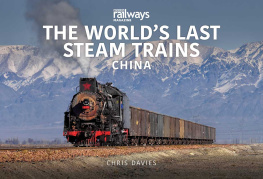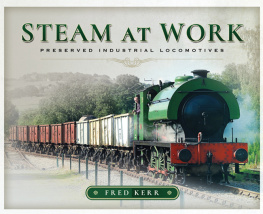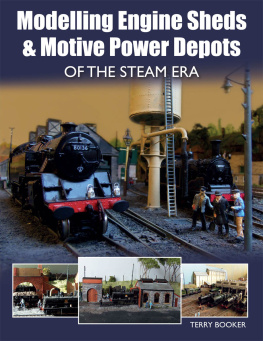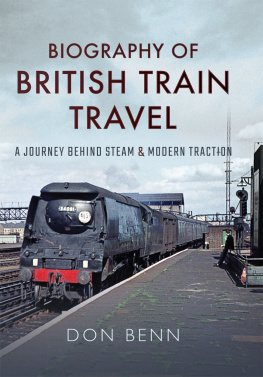CLASSIC AMERICAN LOCOMOTIVES
Copyright 2012 by Skyhorse Publishing
No claim is made to material contained in this work that is derived from government documents. Nevertheless, Skyhorse Publishing claims copyright in all additional content, including, but not limited to, compilation copyright and the copyright in and to any additional material, elements, design, or layout of whatever kind included herein.
All Rights Reserved. No part of this book may be reproduced in any manner without the express written consent of the publisher, except in the case of brief excerpts in critical reviews or articles. All inquiries should be addressed to Skyhorse Publishing, 307 West 36th Street, 11th Floor, New York, NY 10018.
Skyhorse Publishing books may be purchased in bulk at special discounts for sales promotion, corporate gifts, fund-raising, or educational purposes. Special editions can also be created to specifications. For details, contact the Special Sales Department, Skyhorse Publishing, 307 West 36th Street, 11th Floor, New York, NY 10018 or .
Skyhorse and Skyhorse Publishing are registered trademarks of Skyhorse Publishing, Inc., a Delaware corporation.
Visit our website at www.skyhorsepublishing.com.
10 9 8 7 6 5 4 3 2 1
Library of Congress Cataloging-in-Publication Data is available on file.
ISBN: 978-1-61608-824-8
Printed in the United States of America

The Largest Locomotive in the World
Weight of Engine, 23,000 lbs. Total Weight of Engine and Tender 334,000 lbs.
Complete Description Given on Page 470.

Latest Development of the American Freight Locomotive.
Cylinders 2134 inches; Driving wheels, 55 inches; Weight of Engine, 212,750 lbs.
Complete Description Given on Page 473.

Latest Development of the American Passenger Locomotive.
Cylinders 1826 inches; Driving wheels, 80 inches; Total Weight of Locomotive in Working Order, 134,500 lbs.
Complete Description Given on Page 480.
CLASSIC AMERICAN LOCOMOTIVES
THE 1909 CLASSIC ON STEAM
LOCOMOTIVE TECHNOLOGY
BY
CHARLES MCSHANE
AUTHOR OF
ONE THOUSAND POINTERS FOR MACHINISTS AND ENGINEERS
ILLUSTRATED.

Skyhorse Publishing
TABLE OF CONTENTS.
PREFACE.
It is unnecessary for me to point out in detail what I regard as the most valuable features of this work, as my judgment may be warped by the circumstances that I have found certain subjects more interesting than others. Indeed, in my judgment, every work must stand or fall upon its own merits, and nothing that an author can say in reference to it can avail to change the ultimate verdict of those who subject it to the decisive practical tests that they are called upon to apply in the discharge of their duties.
I desire to express my sincere thanks to the Railway Public for the generous reception accorded my former efforts, and trust that in this work I may be deemed, in some degree at least, to have made good my pledges to the gentlemen who requested the preparation by me of a more comprehensive work on the same subject.
The number of contributors, inventors, locomotive works and mechanical journals who have rendered assistance are too numerous to admit of my thanking them by name, but I beg here to renew to them all the acknowledgments which have already been made to each in person.
C. McS.
Chicago, January 21 1899.
BRIEF HISTORY OF THE LOCOMOTIVE.
The first self-moving steam engine of which there is any record was built by Mr. Nicholas Cagnot in France in 1769. It was, of course, of very crude form, being mounted on a carriage and run upon the public highway, but it was from this insignificant looking little engine that we can trace locomotive construction and development down to the present monsters of the rail. It is true that Isaac Newton has received credit for being the original inventor of the steam engine, but the boiler constructed by him in 1680, and called an engine, cannot properly be so termed because it failed to move, and therefore failed to develop any power. It consisted of a spherical boiler mounted on a carriage and the intended propulsion was through the force of escaping steam against the atmosphere; naturally it proved a complete failure.
To Mr. James Watt, more than any other man, is due the honor of first controlling and utilizing steam for power and perfecting the steam engine, although Newcomer and others had used steam for lifting water, etc., long before Watts time. To Trevithick of England is due the honor of first applying the steam engine to rails, or tramways. His engine bore his name and was first run on the Merthyr Tydvil Tramway in South Wales, February 1, 1804. It was a pronounced success, although it appeared that Mr. Trevithick had built a machine which he could not control, as the engine run off the track and was badly wrecked the first day. The presumption is, however, that it was due to his inexperience as an engine driver. Many other locomotives were soon afterward built in England, several of which have since become famous. American engineers were not sleeping, however, while all this experimenting was taking place across the water. Mr. Nathan Reed, of Salem, Mass., built an engine as early as 1790, it being the first locomotive ever built in America; like the Cagnot engine it was also mounted on a carriage and run on the public highway.
The first locomotive to run on rails in America was the Tom Thumb, built by Mr. Peter Cooper, of New York, in 1829. The Stourbridge Lion being imported from England the same year; it was the first locomotive to cross the ocean. It was about this time that locomotive construction actively began on both sides of the water. The most important factor in the success of the locomotive was found to be the mechanism employed to distribute and control the steam, which was called the valve gear.
Many different forms of valve gear were in use in those early days. What is known as Hook Motion became the standard form of valve gear in this country, and it remained in use for many years after the invention of the shifting link. Those who never saw hook motions can gratify their curiosity by inspecting Old Ironsides, which is located in the Field Columbian Museum at Chicago, I11.
It is believed by many that Mr. William T. James of New York, a most ingenious mechanic who invented the double eccentrics, also invented the link, as he used a link of crude form as early as 1831; but the Stephenson link, which is at present the standard form of link used in this country, was invented in 1842 by Mr. William Howe, an employe of Robert Stephenson & Co., of New Castle, England. Several other valve gears have since been invented but each in turn failed to demonstrate its superiority over the shifting link which is used in one or other of its many forms on a large majority of locomotives. In the early days of locomotive construction many locomotives were imported to this country, but the tide of importation has turned and our builders are now shipping locomotives to all parts of the .world. This is due to the fact that we build the fastest, most powerful and best locomotives in the world; the American locomotive being noted for its simplicity, convenience, speed and power. The largest locomotive ever built, up to the present time, is illustrated on the first page of this book. It was built by the Pittsburg Locomotive & Car Works of Pittsburg, Pa., for the Union Railway of Pittsburg, Pa., and completed during October, 1898. In working order the engine and tender weighs 334,000 pounds.














